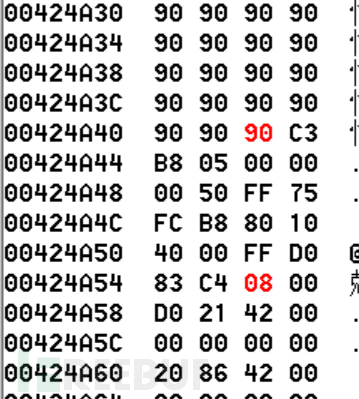|
|
我们怎么写一段代码,能够在程序内存里面不停移动?就是让shellcode代码能在内存中不停的复制自己,并且一直执行下去,也就是内存蠕虫。我们要把shellcode代码偏移出蠕虫长度再复制到蠕虫后面的内存中,然后执行。我们在实现过程中同时把前面同长度代码变成\x90,那个就是虫子走过的路,最终吃掉所有的内存。实现这个我们要知道shellcode长度,并且计算好shellcode每次移动的位置是多少。我们的shllcode以调用printf函数为例。
0×01 写出printf程序- #include "stdio.h"
- int main()
- {
- printf("begin\n");
- char *str="a=%d\n";
-
- __asm{
- mov eax,5
- push eax
- push str
- mov eax,0x00401070
- call eax
- add esp,8
- ret
- }
- return 0;
- }
0×00401070 是我机子上printf的地址,将自己机子上的printf地址更换一下就行,还要在最后加一个ret,因为执行完shellcode还要回到复制shellcode的代码执行。 上面汇编转成shellcode形式,shellcode为: - char shellcode[]="\xB8\x05\x00\x00\x00\x50\xFF\x75\xFC\xB8\x70\x10\x40\x00\xFF\xD0\x83\x**\x08\xc3";
- insect:mov bl,byte ptr ds:[eax+edx]
- mov byte ptr ds:[eax+edx+20],bl
- mov byte ptr ds:[eax+edx],0x90
- inc edx
- cmp edx,20
- je ee
- jmp insect
-
- ee: add eax,20
- push eax
- call eax
- pop eax
- xor edx,edx
- jmp insect
shellcode长度是20,假设数据的地址是s,我们把数据复制到地址为s+20处,原来的数据变为0×90,表示数据曾经来过这里,insect段是用来复制数据用到,复制了20次,刚刚好把shellcode复制完。 因为shellcode相当于向下移动20位,所以我们要把eax加上20,还要把edx恢复成0,方便下次接着复制,然后去执行我们的shellcode,接着跳转到insect段继续执行,这是ee段干的事。 inscet和ee段加起来是复制我们的shellcode到其他地方,然后去执行shellcode,然后再复制,循环下去。 0×03 最终程序- #include "stdio.h"
- char shellcode[]="\xB8\x05\x00\x00\x00\x50\xFF\x75\xFC\xB8\x70\x10\x40\x00\xFF\xD0\x83\x**\x08\xc3";
- int main()
- {
- printf("begin\n");
- char *str="a=%d\n";
-
-
- __asm{
-
- lea eax,shellcode
- push eax
- call eax
- pop eax
- xor edx,edx
-
- insect:mov bl,byte ptr ds:[eax+edx]
- mov byte ptr ds:[eax+edx+20],bl
- mov byte ptr ds:[eax+edx],0x90
- inc edx
- cmp edx,20
- je ee
- jmp insect
-
- ee: add eax,20
- push eax
- call eax
- pop eax
- xor edx,edx
- jmp insect
-
- }
-
-
- return 0;
- }
调试的时候找到shellcode位置,一步步调试能看见shellcode被复制,原来的转成0×90,并且printf还被执行 没有复制前: 
复制后:

0×04 总结我们要先计算出shellcode的长度,计算好shellcode每次移动的位置是多少,然后写出复制程序,并且还要有调转到复制后的shellcode首地址程序,执行复制后的shellcode,接着在复制再执行,循环下去,当然在一段内存里循环执行也可以,只要找到位置,跳转过去就行
|
|